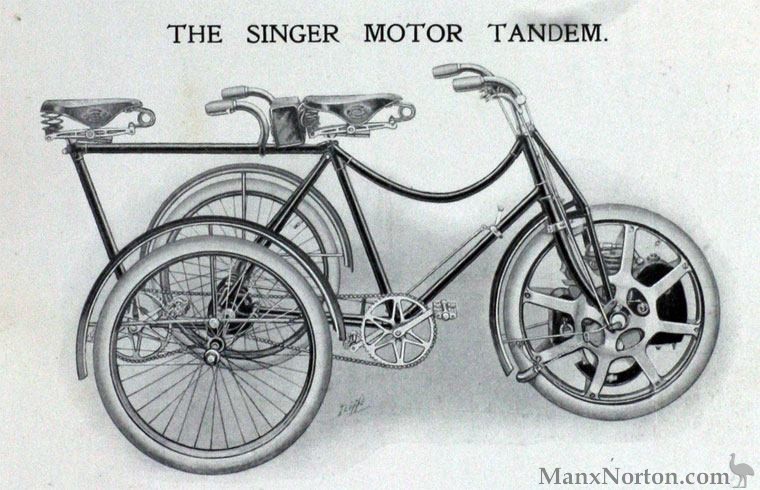




The Singer company was founded in 1875 by George Singer as a bicycle manufacturer in Coventry after he left Coventry Machinist. Singer built the world's first safety bicycle.
NEW RIM BRAKES - Report from The Sphere, 1st December, 1900.
"The two autumn cycle shows which have been running concurrently in London this week - the Stanley Show at the Agricultural Hall, Islington, and the National Show at the Crystal Palace - have introduced no startling novelties into the world of wheels. The Singer Motor Wheel perhaps most holds the eye. Much however has been done to improve the parts of a cycle. Next season's cycles will, therefore, look very similar to this years, but they will be very much more easy to adjust and use."
1912 By this year, Singer had a wide range of machines on their lists. They built a 499cc racing engine, with a four-valve head and water cooling. It was meant to be raced at Brooklands by the Singer rider G. E. Stanley, but he preferred his successful and reliable sv model. Over the next couple of years the range continued, with steady developments.
1914 Late that year, a two-stroke, two-speed, chain-cum-belt driven model, built under Peco patents, was added. It also had Druid forks and foot-boards.
1915 That range continued for a short time but World War I brought production to a close, and after the war was over the company's attention returned to cars.
Singer and Co., LTD., Coventry.
This model will shortly be replaced by a similar machine having a two-stroke 2¾ h.p. engine, 349 c.c.; counter-shaft two-speed gear, 5 and 9.5 to 1.; and drip feed lubrication to cylinder.
1906 Singer and Co Ltd own all the shares of the Singer Motor Company. George Singer and J. Stringer are directors.
1920 Acquired Coventry Premier.
1922 Acquired the Coventry Repetition Co.
1922 Directors were; Rodolph Fane De Salis (Chairman), A. C. Bourner, W.E. Bullock and George Albert Eastwood.
1925 Acquired Sparkbrook Manufacturing Co.
1925 Acquired Calcott Brothers.
1927 Ceased production of cycles.
1936 Became a public company.
1956 The company was in financial difficulties and the Rootes Group who had handled Singer sales since before World War I, bought the company, and closed the Coventry works.
Sources: Graces Guide, The Motor Cycle
If you have further information or a query related to this page, please contact us